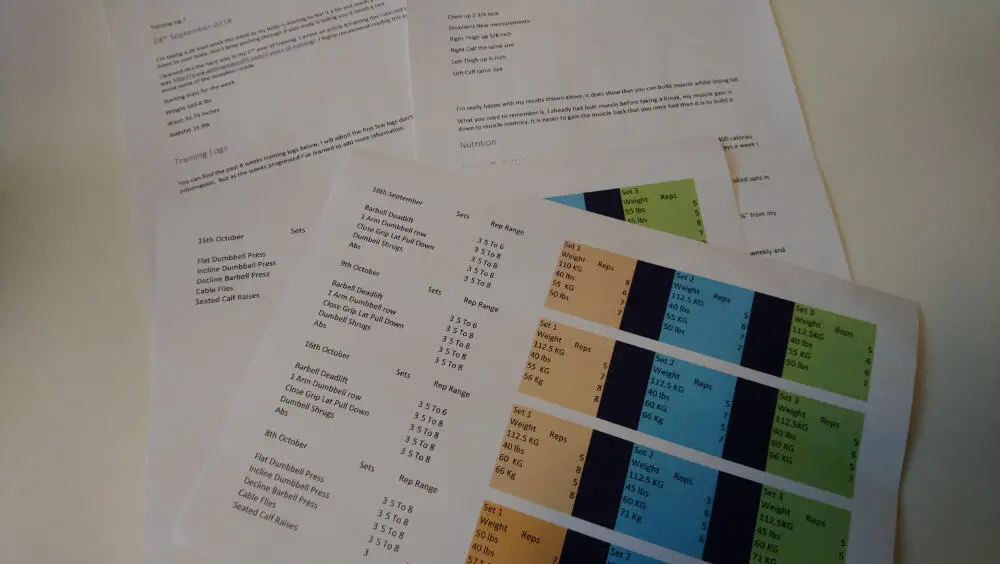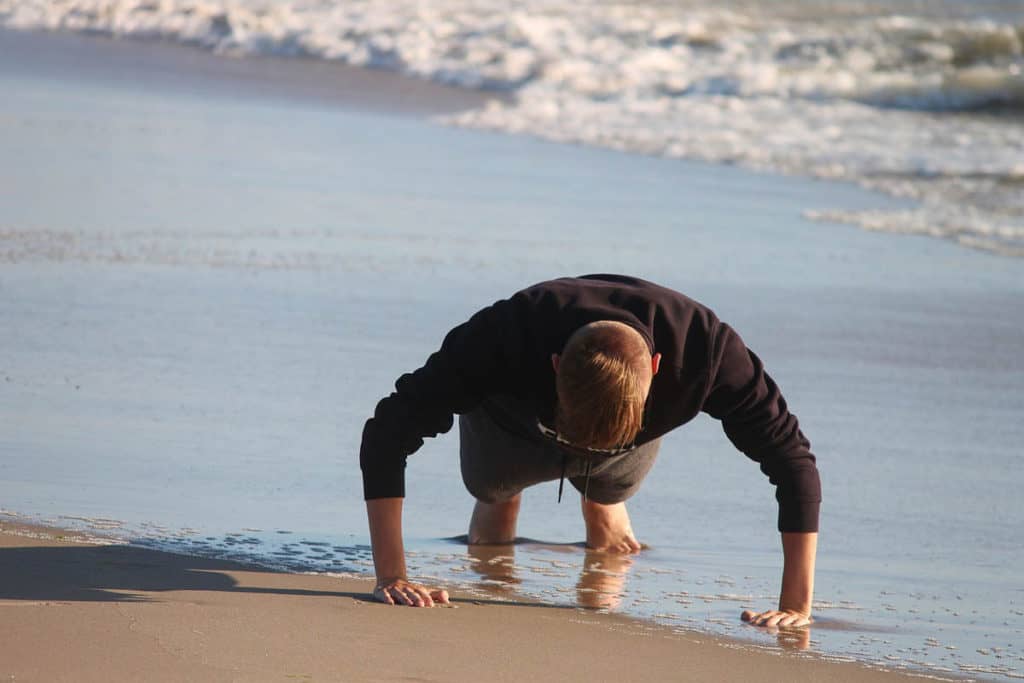Just because you are getting slightly older, it doesn’t necessarily mean you’ve got to stop moving. Ideally, physical activity is essential to caring for your heart as a senior; and there are multiple cardio exercises for seniors to try in the comfort of their own home.
A study in 2014 published in the weekly Morbidity and Mortality report outlines that a staggering 28 % of American seniors are regarded as ‘inactivity’ roughly 31 million sedentary individuals. Ideally, this study outlines’ inactive’ as moving no more than needed to perform the essential daily life functions.
While the findings outline much more than the enduring public health crisis in the USA, the significantly high numbers outline another disturbing trend: so many seniors are not aware of how to take care of their aging bodies.
Cardio workouts are among the most effective ways you can remain active as a senior, and lucky for you, you need not enroll in a gym to get going. You can effectively incorporate a practical, moderate cardio workout at home, whether you have much equipment or space.
A good cardio home workout doesn’t require a ton of fancy equipment or space. Essentially, doing a quick cardiovascular home workout is much easier and more accessible than you may think. Not only is it practical, but it is also much more convenient and affordable.
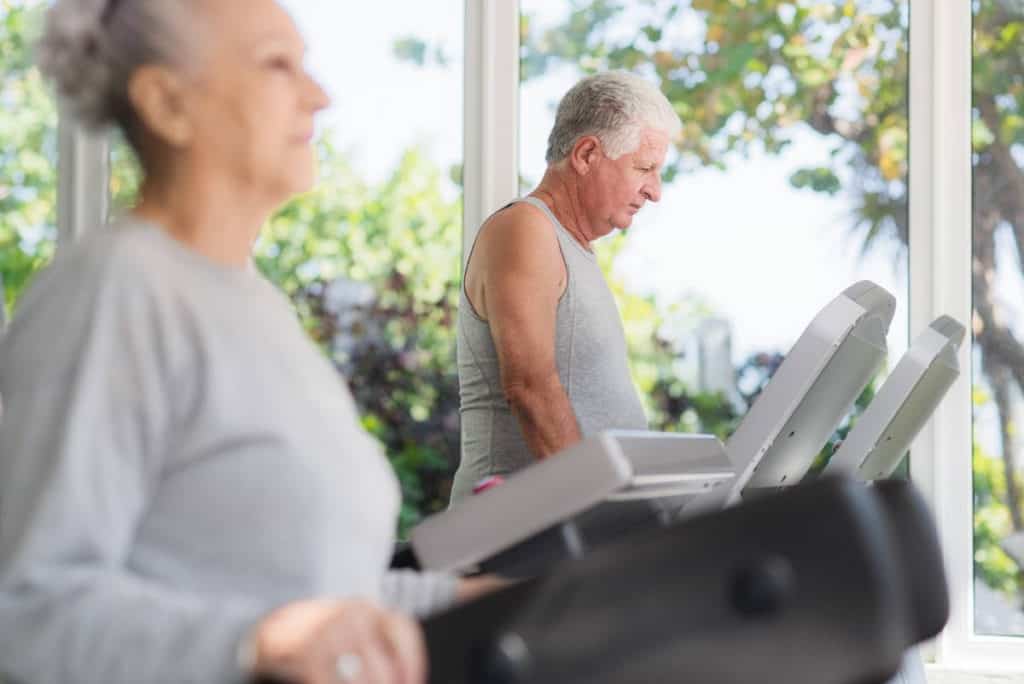
cardio-exercises-for-seniors-at-home
What Is The Best Cardio Exercise For Seniors At Home?
It is not as hard as it sounds. Ideally, the best home cardio workouts for seniors or any other individuals are those that you enjoy enough to engage in daily. The catch here is that the best cardio routines are those that get your heart pumping for about 30 minutes, even when you break the sessions into more manageable 10 or 15-minute workout sessions throughout your day.
Many health experts unanimously state that a bare minimum of two and a half hours a week is ample enough to give you the benefits associated with exercise. What’s more, the forms of exercises you engage in don’t necessarily matter that much as identifying something you delight in and just getting at it! Even half an hour’s worth of cardio, five days in a week, is enough to make the difference. You’ll essentially be breathing much harder and perhaps even break a sweat, and as the saying goes, ‘Just Do It!’
If you are a senior looking to start a cardio workout routine at home, here are some of the best cardio activities. Besides significantly benefiting you, you can perform them anywhere, at any time. With some creativity, you may well establish a distinct personal fitness routine that comprises a wide array of productive cardio activities to help you remain active and stay healthy.
Let’s get started.
Best Cardio Exercises For Seniors
1. Walking
This indoor activity is a fantastic place for seniors to start, especially for those who may not have been regularly exercising. You can do this at virtually any age and begin right away. This is even if you had some past health issues since it is considered a low-impact exercise.
Being a distinct low-impact activity, walking is relatively easy on all your joints. Moreover, it is considered a typical weight-bearing action, meaning that your body works against gravity. This subsequently strengthens your bones, ultimately preventing age-related medical conditions such as osteoporosis in addition to building muscles.
Usually, the intensity is dependent on the terrain and pace. Ideally, walking is among the best cardio exercises seniors can do at home. Seniors who walk experience numerous health benefits, including lower levels of cholesterol, lower blood pressure, reduced heart diseases, and stroke risk, as well as a mental health boost, among others.
Nonetheless, despite the multiple benefits, ensure that you consult with your physician before you start any cardio program – walking included. Also, you can use a pedometer or health app to track your steps.
Start slow and then add a little every day. You may even get some strength training simultaneously by carrying some few light weights in your hands. In my article How Far should a 60-year-old be able to walk, I cover walking in more detail.

2. Jogging A Little Now And Then
This is the next step up from the walking experience. While jogging is an excellent weight-bearing activity, it is also somewhat more of a high impact, so it places more pressure on your joints. Usually, it is regarded as more of moderate-intensity activity, and you, therefore, must speak to your physician before starting.
Essentially, the average jogging pace is between 4 to 5 miles per hour, although depending on the person, it can be somewhat slower. Like with walking, it can range from moderate-intensity to vigorous depending on the terrain.
Jogging is excellent for seniors since it can help in increasing the strength of the bones as well as minimize the risk of getting fractures and osteoporosis.
Related: Is Resistance Training Good for Osteoporosis?
3. Run, Run, Run
Many seniors are known to enjoy running, mainly if they have been at it for years, or whose bodies are adequately conditioned to do it. Typically, running is done at a much quicker pace compared to jogging.
Its higher speed qualifies it as an energetic activity, which is also a standard high-impact to allow it to place significant stress on your knees, hips, as well as your ankle joints. Essentially, seniors who are in view of incorporating cardio workouts within their homes can try this one out. However, it is essential to consult with their physician to ensure that they are in great physical state.
Related: Are Treadmills Safe for the Elderly?
4. Cycling/Biking
While it may not necessarily appear so, biking is ideally a low-impact type of activity that is somewhat easier on your joints compared to running or jogging while still offering all the heart, lung, muscle, and bone-strengthening perks.
The intensity of this activity usually varies from standard low-intensity like a leisurely bike ride across the vicinity, all the way to high-intensity like pedaling, albeit at high speed.
If you want to do it from home, you can use a stationary recumbent bike. Ideally, it is an excellent option for any senior recovering arthritis pain or from back or hip surgery as the position of a bicycle; even a stationary one is quite uncomfortable.
Recumbent bikes are designed with a unique backrest for support. It positions you at an angle where your legs are out right in front of the cycle rather than the usual position of sides. With this position, less stress is put on fragile joints or hips, while offering a remarkable aerobic workout.
5. Swimming
Primarily, swimming works on your whole body, but rather gently, since the water effectively minimizes the stress put on joints and bones. Therefore, if you are a senior looking for a great cardio workout, this is a fantastic activity, especially for anyone who has suffered any previous injury or has a somewhat fragile body.
Swimming is a remarkable cardio exercise that seniors can do and which can effectively assist with balance. According to a recent Australian study, men known to swim regularly have 33% less chance of falling in comparison with other men who don’t exercise. The research indicates that this is since unlike typical land-based sports, the swimming activity mandates that you establish your support base, while simultaneously producing a coordinated movement of your lower and upper body.
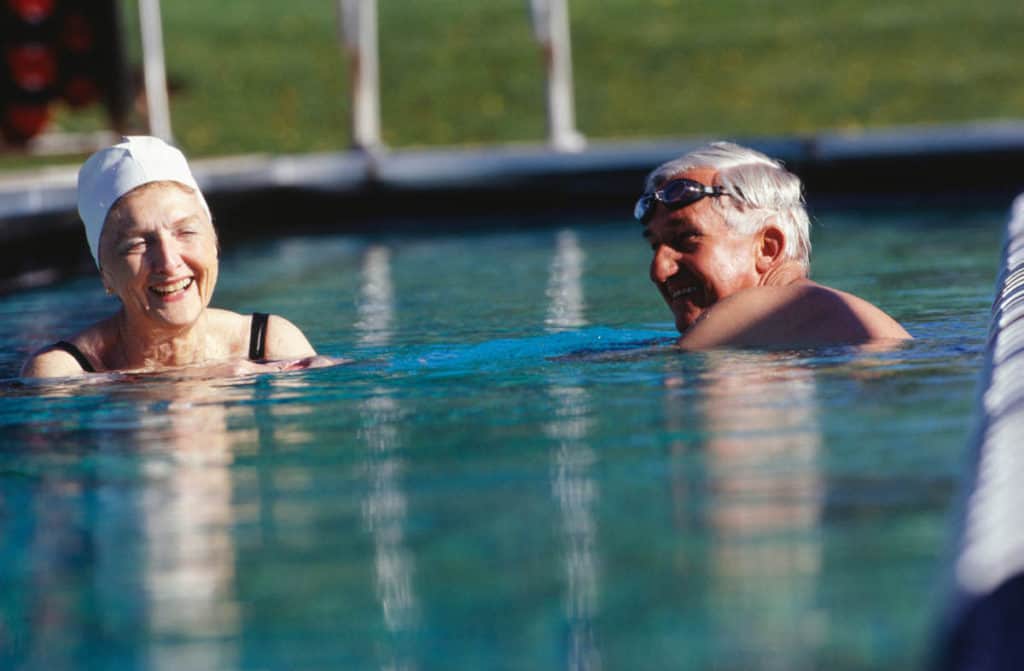
Regardless of your age or fitness levels, swimming is an ideal cardiovascular activity. Among the reasons why it is suited for seniors is that once your body is submerged into the water waist-deep, your weight is about 50% of what you feel on land. Consequently, if you immerse yourself neck-deep, the overall weight you feel is about 10 %. Essentially, being a senior, this particular weight difference is quite critical since it affords you more freedom of movement.
Swimming is essentially quite gentle, especially on the joints, and it also gives you a remarkable cardiovascular and whole body workout. Like with other cardio exercises, ensure that you go slowly while at it. Generally, you can begin with 5 minutes and proceed to increase the overall swimming duration for your sessions gradually. Once you are comfortable in the water, you can always incorporate something extra such as a swim dancing class, to bring some more fun into the sessions.
6. Dancing
A fondness for dancing and partner dancing to be specific is an art that appears lost on the majority of the younger generation, although many seniors will tell you that they still enjoy this. Typically, dancing requires some constant movement, albeit at your pace, something that elevates your heart rate and allows the heart to pump oxygen slightly faster through your blood. In essence, this is why it is considered great cardio or aerobic workout. Depending on what dance style you choose as well as the pace at which you do it, dancing usually ranks as a low to moderate activity.
According to many studies, older adults who are known to dance regularly significantly benefit from it. Engaging in this exciting activity not only adds to the fun, but also boosts your energy levels, and also minimizes your risk of heart disease, high Blood Pressure, and diabetes. Moreover, it also strengthens your heart, not to mention boosting your mood.
Better yet, the American Council on Exercise outlines that dancing as a cardio activity can also assist in enhancing your memory. Dancing is a fantastic cardiovascular exercise, especially for seniors looking to improve on various things such as endurance, muscle strength, and balance.
Fortunately, the type or style of dancing you choose is not essential provided you are dancing. Nonetheless, various individual forms of dancing ranging from hip hop to ballet are also challenging but fun ways for any senior to keep fit, not to mention strengthening their bones and muscles. And considering you can practice it at home, why not try it out?
7. Do Some Yoga!
If you are a senior wondering how to incorporate cardio activities into your routine at home, then one of the most effective ways is to nurture a personal yoga practice. Yoga is essential for everyone and is good no matter how old you are.
Yoga is a fantastic art that has been here for more than five centuries, and it is suitable for individuals of all physical levels and ages, including seniors having mobility issues.
Typically, we perceive yoga as a muscle-toning and stretching activity. However, the reality is that it goes beyond this. Many seniors can benefit enormously by practicing yoga, including reducing blood pressure, increasing joint movement, as well as regulating your sleeping cycle. Moreover, yoga has been seen to reduce depression significantly.
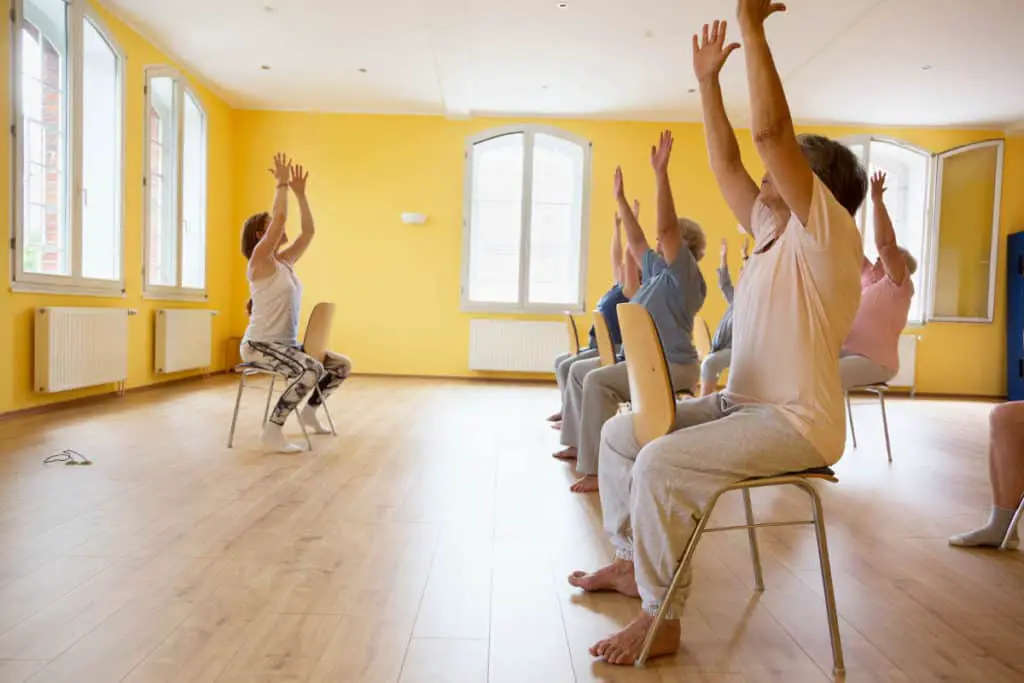
If you are a senior who has never done yoga at all, a great starting point would be to start with Vinyasa yoga. This is a distinct yoga activity that comprises different poses and sequences. How you ultimately combine them effectively determines the required endurance and the overall cardio output.
Vinyasa yoga is usually characterized by distinct sequences that combine poses in a flowing way that mandates more endurance. Some more vigorous styles such as Ashtanga and power yoga are performed at a relatively higher intensity and with little rest. These activities offer a heart-pumping workout, which subsequently provides multiple benefits, including flexibility, muscle toning, as well as balance, all of which are essential for seniors as they age.
For any senior with significantly limited mobility, the best approach would be starting with some chair exercises and then moving up to various yoga poses. Once you get comfortable with the Vinyasa yoga flows and your heart rate is adequately controlled, you may then proceed to some more vigorous styles, such as the power yoga and Ashtanga yoga poses mentioned above.
I’ve written a couple of articles you might be interested in 12 Reasons Why Chair Yoga is Great for Seniors and Does Chair Yoga Help with Balance?
8. Glide Through Your Cardio With Elliptical Machines
If you are well equipped with extra resources and some space in your home, then an elliptical machine will offer an excellent low-impact workout. Usually, this machine utilizes a gliding leg motion, which effectively minimizes stress on your joints, and handlebars that work your upper body. With this machine, there is minimal joint stress, a characteristic that makes it an ideal fit for seniors with arthritis or any other conditions.
What’s more, with its adequately stable design in addition to the unique four-point balance (arms and feet), the elliptical machine is a somewhat secure option for the older people who might not have good coordination or balance.
With this machine, you get an entire body workout, that can also boost your intensity by effectively altering the resistance, enabling you to work much harder, all without pounding the body.
9. Squats
Finally, squats are among the best at-home cardio exercises suited for seniors since not only do they boost the heart rate, but they also promote lower body strength. Usually, mastering the proper form may also be a trial and error process, something that may make seniors feel much more comfortable doing this exercise away from the public.
Nonetheless, to properly reap all the perks that come with this exercise, you can browse the web for some tutorials on the correct form. Also, exercise apps, fitness blogs, as well as YouTube videos are great resources that can assist by affording a visual and proper guide.
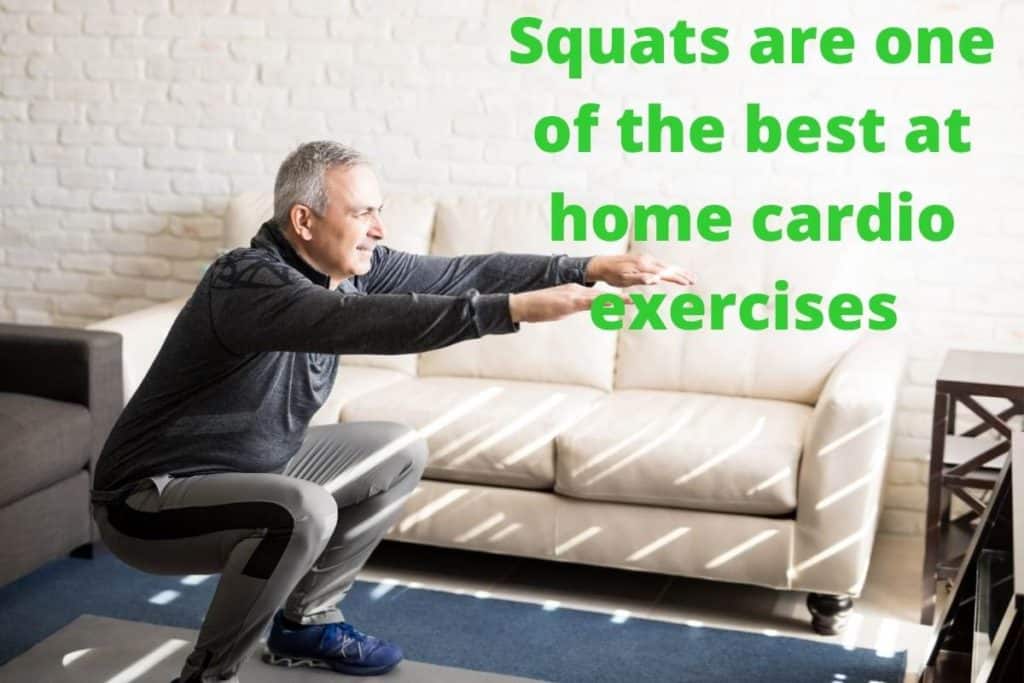
Is Cardio Good For Older Adults?
For your weekly workouts, cardio is the way to go. Physical activity and exercise are among the best ways of keeping seniors engaged. In fact, regular exercise can also help in reducing dementia sleeping issues.
What’s more, by staying active, seniors can aid in preserving mobility, diminishing the need for extensive home modifications in the future.
Here are several ways that cardio will aid your body to stay healthy:
Better Heart Health
Among the significant elements of cardio workout is that it significantly increases your heart rate. Most of the heart is made of muscle and functions under similar rules as other muscles. The more work it does, the stronger it becomes. Cardio keeps the heart muscles healthy, decreasing the beats per minute required to keep the body with sufficient oxygen.
Reduces Your Body Weight
Similar to all other workouts, cardio will help you reduce your weight. It might not be the best way to burn calories, though its intense routine, as well as its full-body focus, makes it an excellent technique to lose the extra weight.
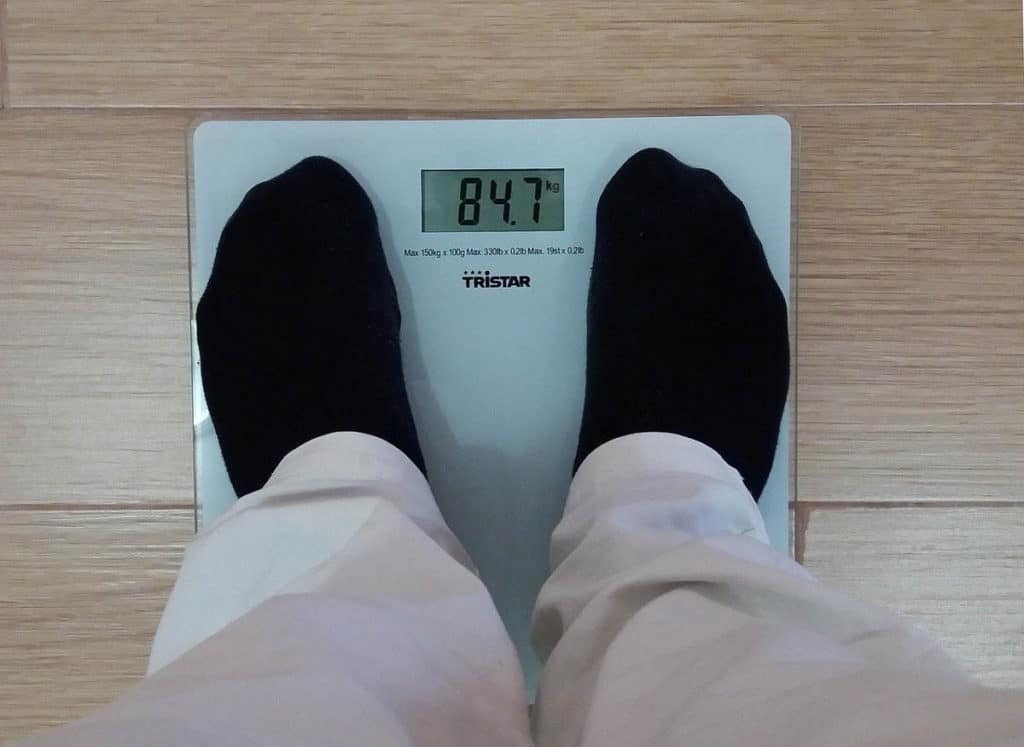
Reduces Stress
Working out typically helps the body excrete endorphins, which is basically the “happy” hormone that betters your mood and decreases your stress levels. This doubles up if you start boxing or martial arts, nothing will reduce your stress better than hitting the punching bag a few times.
If you are more of a sports-person, you will find yourself concentrating on the sport rather than whatever is stressing you. This offers you a mental break from all your troubles.
Workout Tips
Cardio, similar to all exercise techniques, can be taken up quickly. However, it requires a lot of discipline; therefore, starting a cardio exercise is worth sitting back and considering how you are going to go about it. Before you begin on your cardio journey, here’s what you need to consider:
Set Realistic Goals
Nothing kills the motivation to exercise more than an attainable goal! Whatever you are trying to achieve, whether weight loss or attempting to attain a particular heart BPM, you should avoid shooting for it instantly. In fact, if it is of assistance, refrain from setting an objective based on a result. Remember, in case you do fall short on your goal, refrain from playing catch up, but simply continue from where you last left off.
If you would like to read more about goal settings check out my article Why You Should be Setting Fitness Goals For Your Key to Success
Create A Plan
You must figure out exactly how you will carry out your exercise routine. This can be particularly easy if you are working on an exercise that requires no equipment whatsoever. This can be as easy as choosing several options you prefer and the rotations between the sessions. Whatever you do decide to go for, ensure you stick with it, unless you discover that it is not working out for you as you had hoped. Then choose something else but don’t give up on exercise.
Report Back To Someone
This is especially important for you that know that you tend to put off exercise. If this describes you, try to identify a training partner who can help you out. The idea is for you to find someone who will continuously keep tabs with your progress and ask you how you are getting on with your routine. Statistics have indicated that reporting back to a responsible individual helps you keep on track.
Don’t Forget To Warm Up And Cool Down!
Warm-up is significant in your quest to remain active. Before diving into your home cardio workout, you need to warm-up your muscles. You can start by warming up for approximately 5 minutes before starting your session.
The best way you can start is to walk slowly and then proceed to stretch, among other warm-up activities. For seniors, in particular, this is quite important as warming up before your cardio exercises to increase your temperature as well as your muscle flexibility, while also helping you remain safer and more efficient during your cardio workout sessions.
What’s more, warming up before vigorous or moderate-intensity workout facilitates a gradual increase in breathing and heart rate as you begin your sessions. Also, stretching before any resistance training workouts decreases your strength temporarily and can result in injuries.
Just like with warming up, it is also crucial that your muscles get cooled down, although this is after the cardio exercise. After any physical activity, cardio included, your heart will still be beating relatively faster than usual, while the temperature of your body will, of course, be higher, and your blood vessels dilate.
This means that stopping too fast could lead you to pass out or to feel sick. Cooling down after physical activity enables a gradual decrease towards the end of your session. The best way you can cool down is to walk or even go on with the activity you were performing but a relatively slower pace for around five minutes or maybe until your heart rate goes down below 120 beats per minute.
You can take time to do some stretching after your cardio session as it will boost your flexibility and also assist in reducing lactic acid build-up that can result in stiffness and muscle cramping.
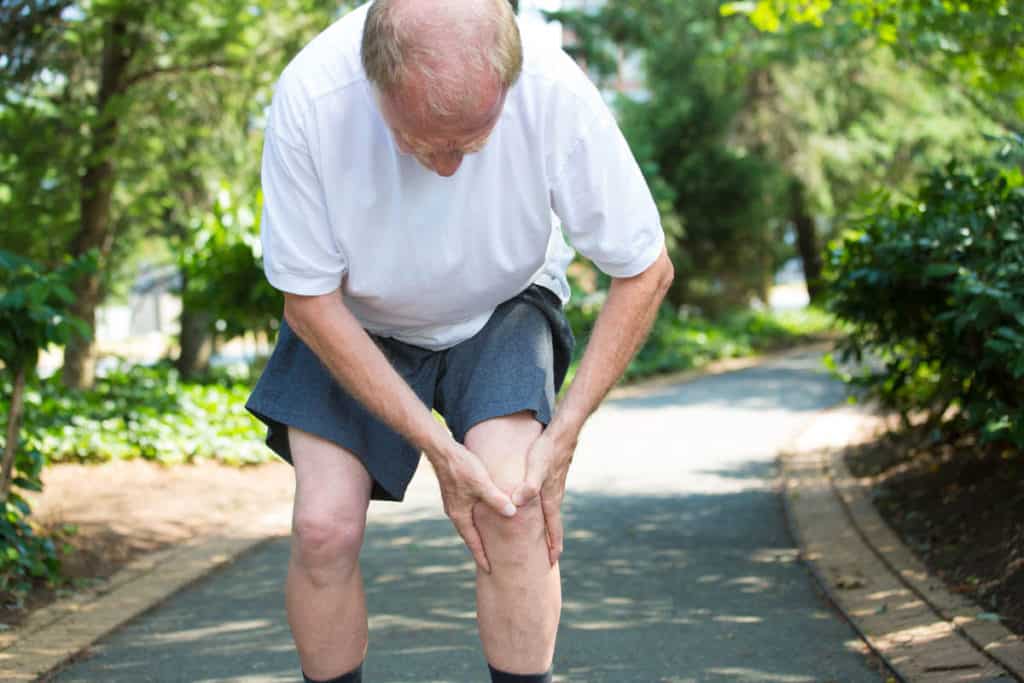
How Often Should I Exercise?
According to the USA Disease Control and Prevention Centers, the recommended time for exercise for seniors (over 65 years of age) is at least 2 ½ hours of some moderate physical exercise, or about 75 minutes worth of vigorous physical activity or a combination of both every week. Similarly, you must do some strength training for at least two days a week, although you can work on your flexibility or balance each day.
Seniors who have pre-existing conditions must consult with their physicians on the amount of cardio and physical activity you should perform, as well as the various forms of cardio workouts is suitable for them. However, the average is approximately 30 minutes on most weekdays.
What’s more, you must add physical activity within your daily routine. Some of the simple examples of working out activities into your routine include:
- Deciding to take the stairs in place of the elevator
- Cycling or walking instead of driving
- Parking your vehicle slightly farther away from your destination
- Working out in your yard
- Walking your dog
- Carrying out some light exercises as you watch your TV
Get Yourself Moving Again With These Amazing Cardio Exercises For Seniors
As a senior, don’t underestimate the significance of cardiovascular activities. Although cardio is generally considered a rigorous and intense form of exercise, there are multiple ways that seniors can remain active without causing any damage. With numerous simple home routines at your disposal, there is a myriad of options to pick from.
Cardio activities can be the difference between leading a full happy life and having to deal with radically restricted mobility, which stops you from doing all that you love. As you age, the body obviously changes, and more and more health issues can crop up, and you, therefore, you need to remain active.
Staying active may not only keep you feeling great but also looking sharp at each stage of your life. A diligent routine is especially significant for seniors and their health since regular exercise can assist in the prevention of diabetes, heart disease, some cancer forms, not to mention reducing pain that comes with arthritis.
Physical activity and cardio benefit much more than your body-it can also boost your emotional and mental health by leading an active lifestyle. Remain active, stay involved, and you will remain fit and healthy!
Fight back any aging signs and enjoy your life more with these few at-home cardio exercises for seniors. However, remember to consult with your physician before you start a new exercise program.
Good luck!

